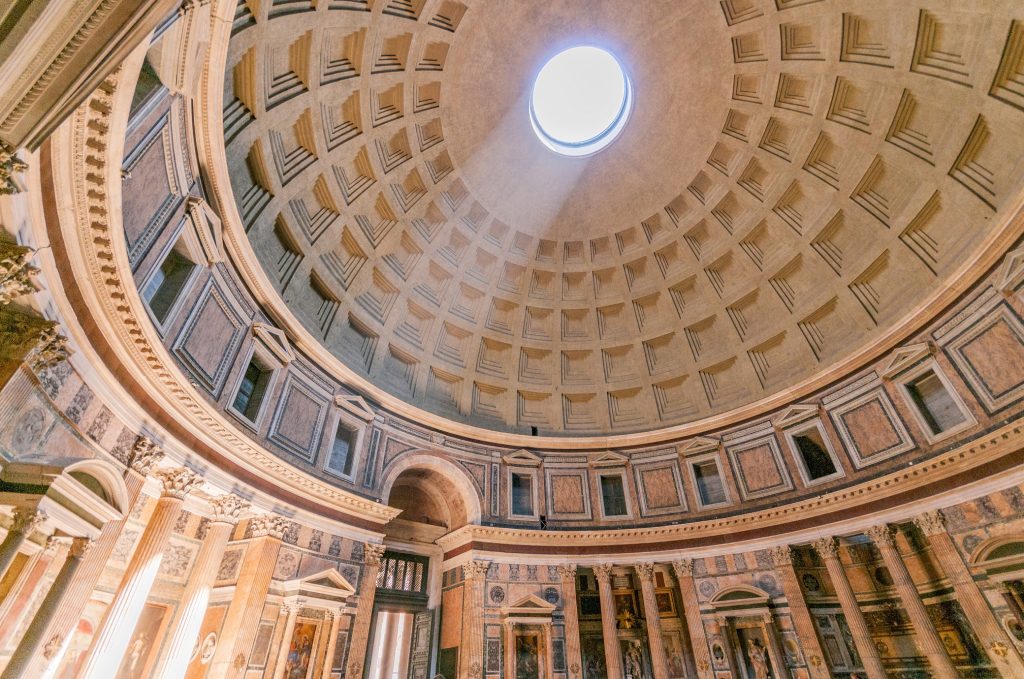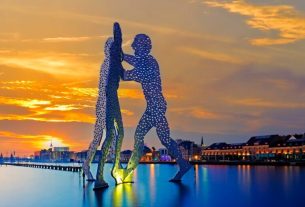The Pantheon is the only building in Rome that has survived almost unchanged from ancient times. Once dedicated to Roman deities, it later became the city’s first Christian church. During its turbulent history, it burned down several times and eventually became the final resting place for many notable people. Today it is a World Heritage Site and one of the biggest tourist magnets of the Eternal City.
Right in the heart of Rome, where there is no shortage of historical monuments, stands an imposing building which has shaped the image of the Eternal City for over 2000 years. A massive dome, for centuries the largest in the world, crowns the Pantheon, built as a dedication by the Roman emperors to their gods. And the temple is still a house of faith today, since it was consecrated in the early 7th century as the city’s first Christian church. TRAVELBOOK tells the eventful story of the marvelous building, which today is one of the biggest tourist magnets in Rome.
The Pantheon has existed since ancient times
According to official site of the Pantheon a first version of the mighty building was built between 27 and 25 BC Marco Agrippa, son-in-law of the first Roman emperor Augustus, had a temple built in which all the Roman gods were to be adored. The name of the building alone is proof of this, because pantheon means “all gods” in Greek. However, this first historical version of the now legendary building didn’t even last 100 years and it burned down in a fire around AD 80. The same thing happened to the second pantheon, only about thirty years later it too was consumed by flames.

Between 118 and 125 AD, the emperor Hadrian had the Pantheon built, which has survived almost unchanged to the present day. This makes it the only building from Roman antiquity that achieved this feat. The symbol of the temple of the gods will be its majestic dome, the size of which will remain unsurpassed for centuries. This is designed in such a way that daylight illuminates the room in different ways through a round hole, depending on the time of day and the season. This phenomenon is particularly striking at the winter and summer solstices, and twice a year at the equinoxes.
Also interesting: Top tips for Rome by night
The side “HistoryAccording to this, the Pantheon is believed to have been consecrated between AD 126 and 128. Due to lack of documents, it is no longer possible to determine who the architect was. Nor why an inscription was placed above the entrance portal, which still embellishes the building today. It reads in large letters: “Marcus Agrippa, son of Lucius, thrice consul, built this.” Presumably this is a tribute to the “father” of the very first pantheon. Incidentally, under Hadrian the building served not only as a place of worship, but also as a place of jurisdiction for the city.
The temple of the gods becomes a church
From 330, however, both the Pantheon and Rome continued to lose importance when the emperor Constantine moved the capital of his vast empire to Byzantium, today’s Istanbul. It wasn’t until almost 300 years later that the fate of the building underwent a decisive change. Because in the year 609 Pope Boniface IV obtained permission to transform the former pagan temple into a Christian church. It is now renamed Sancta Maria ad Martyres, which means “The Holy Virgin and the martyrs”. It is only thanks to this rededication that the Pantheon still exists today almost unchanged. Because the church has the financial means to maintain its new place of worship accordingly.
By the Renaissance at the latest, the Pantheon had become an architectural icon whose ideal was emulated by countless contemporary artists. Michelangelo, known for the Sistine Chapel, even believes that the building must have been created by angels. It served as the inspiration for a number of other world-famous buildings over the next few centuries, including the Capitol in Washington. Not surprisingly, some famous people choose this special church as their final resting place. Among them are, for example, the painter Raphael, but also the Italian king Victor Emmanuel II.

Today world heritage
When Italy became a united country under him in 1861, the Pantheon also underwent its last major restoration to date. Two bell towers that previously adorned the building are now being removed. But this didn’t bother the Romans, because in the vernacular they were still known as “donkey’s ears”. In 1980 the Pantheon received a special honor when it was recognized as part of the historic center of Rome by the Unesco as a World Heritage Site it is recognized. Today, every year, several million people visit the Piazza della Rotonda, where it has stood for more than 2,000 years.
AAlso interesting: 12 things to avoid in Rome
Today, the Pantheon is one of Rome’s major tourist attractions, but it still serves as a church. Church services and masses are held here on a regular basis. You can find out about upcoming events on the official website. The domed building is usually open to visitors from 9am to 7pm daily. Admission is free. But if you want, you can get one of Tour options book, prices vary. Be careful in bad weather: the round hole in the dome not only allows the sun’s rays to penetrate the building, it also occasionally rains inside. However, holes in the floor ensure that the water can drain again. But if you get wet, don’t worry. Just think of it as a sign from the gods.




